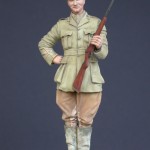

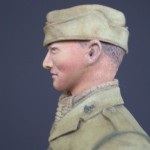
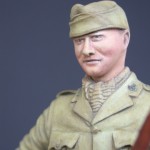

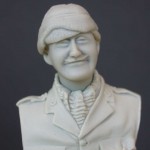
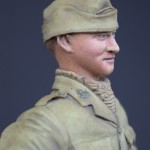
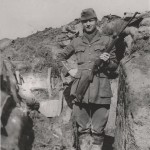
2nd Lieutenant, Durham Light Infantry, Flanders, Spring 1915 – Sniper – Special Offer / Offizier der Durham Light Infantry – Scharfschütze – Sonderangebot
- Scale / Maßstab: 1:16
- Approx. height of figure: 113mm
- Material: Resin
- Parts / Teile: 11
- Infosheet / Infoblatt: English
- Code: 09DLI
Contents / Inhalt:
- Figure (8 parts) / Figur (8 Teile)
- Alternative Head with Balaklava / 2. Kopf mit Balaklava-Mütze
- Mauser Sporting Rifle .303 (inch) / Mauser Sportsgewehr
- Figure Base / Figur-Sockel
Extracts from the Infosheet with this figure:
The figure depicts a 2nd Lieutenant of the 2nd Battalion, the Durham Light Infantry in the spring of 1915. The original photo depicts him attempting some sniping along the British front line at a place called Hobb´s Farm, northeast of Houplines, Armentieres. His field service cap has been turned around back to front, avoiding the shine from the two small brass buttons giving his position away. This young officer of around 20 years of age, is now posing in the spring sunshine, whilst holding the .303 in. Mauser sporting rifle. The Marquis of Londonderry loaned this rifle made by John Rigby of London to the 2nd Bn. DLI in 1914 as a sniper rifle. This rifle can now be found at the Regimental Museum, Durham.
The 2nd Battalion, Durham Light Infantry was a regular unit, mobilizing from Whittington Barracks, Lichfield, in 1914 and in the cause of the war suffered over 5300 casualties.
Field Service Side Cap: Worn by both officers and other ranks. The side flaps could be folded down and fastened under the chin for added protection during bad weather (in this form seldom seen). Colour: khaki drab. Khaki – an Urdu word meaning dusty. The dye for the material originally came from India and was made out of tea, or mud.
2nd Head: The alternative head shows the issued cap comforter, a more practical headdress for the front line (used also on night-time trench raiding). Colour: Khaki (often with more green).
1913- 18 Pattern Service Dress Tunic: The service dress tunic had a set in waistband, with a brass hook on each side to support the belt and would normally have been worn with a tie. The correct belt for wearing with the service dress is the Sam Browne (a brown leather rig designed by the British officer Captain Sam Browne of the 2nd Punjab Irregular Cavalry, during the Indian Mutiny in 1857). At this early stage of the war line officers wore their rank on the cuffs (Foot Guards on the shoulder straps), using chevron lace and worsted embroidery of a light drab (or cream coloured) thread. The two DLI collar dog badges on the tunic collar would have been a dull/dark brass colour. The buttons in the Light Infantry would normally be in Rifle Black, but a few officers wore brass buttons (as seems to be the case with this officer). Colour of tunic: khaki drab.
Lanyard: Standard regulation Light Infantry green whistle lanyard, worn over the left shoulder and under the shoulder strap.
Lanyard: Standard regulation Light Infantry green whistle lanyard, worn over the left shoulder, under the shoulder strap.
Breeches: Riding breeches with reinforced inside leg material. Worn by many officers of all ranks during the war. In the attack, especially during the first years, it was possible for the German snipers to distinguish between the officers and men, simply because their legs appeared thinner. Colour: khaki.
Rubber Trench Waders: These appear to be either cut-down trench waders or Wellington rubber boots. Ideal for the static trench warfare, especially in Flanders. Colour: grey.
The Base: The base supplied with the figure depicts the bottom of the trench, where the officer is standing. The slightly raised parts are the front trench wall (larger of the two) and the start of steps cut out in the earth at the rear. The three spent cases have been trodden into the mud.
 An deutschsprachige Interessenten:
Sie können mich per eMail oder Telefon auch gerne auf deutsch kontaktieren. Ortsbesuch ist nach Absprache möglich.
An deutschsprachige Interessenten:
Sie können mich per eMail oder Telefon auch gerne auf deutsch kontaktieren. Ortsbesuch ist nach Absprache möglich.
